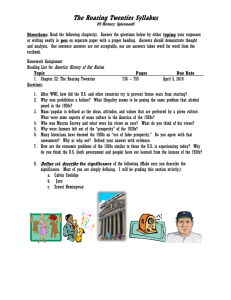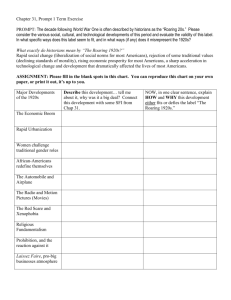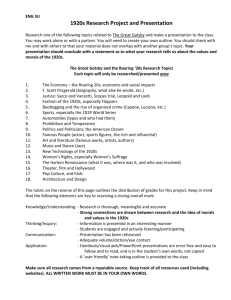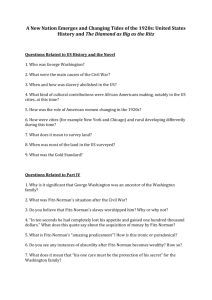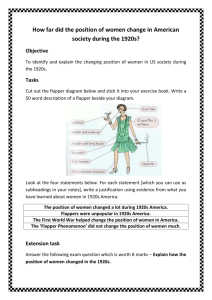Today
advertisement
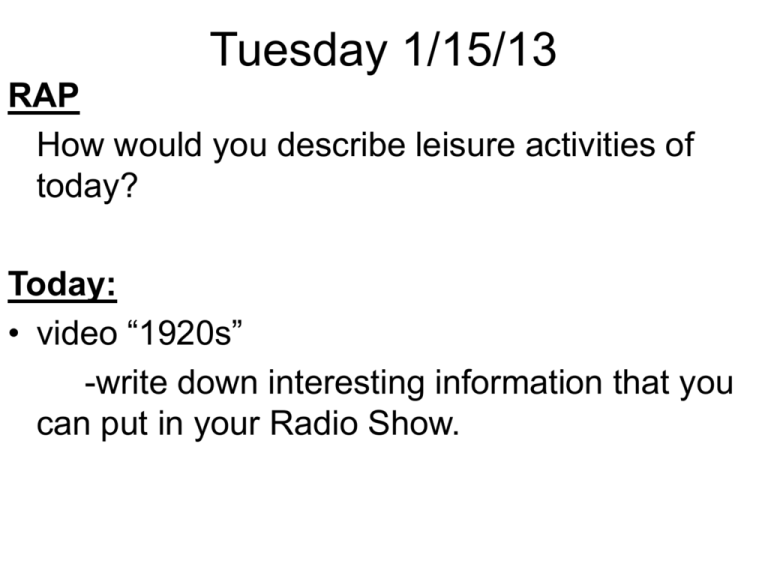
Tuesday 1/15/13 RAP How would you describe leisure activities of today? Today: • video “1920s” -write down interesting information that you can put in your Radio Show. Wednesday 1/16/13 RAP 1. What did you find interesting in the video yesterday? Today: • 1920s Video • HW: Ch. 12.1 – review on Thursday. – – – – – – – – Standard of livingCreditMass mediaFlapperNew Ways of buyingRoute 66- Page-384-385 Youth and the “Roaring twenties”Describe changes that industrialization, the automobile, advertising, and the new youth culture brought to American life. Today: • Watch 1920s video.— – Take notes---things you may want to put in your Radio Show. • Read Ch. 12.1: – complete your ch.12.1 (if you do not finish 12.1; please finish it by Thursday.) • Ch. 12.2 is DUE Friday and is HW • Work on your Radio Show– Start breaking up the show • • • • Commercials --2 Script Music 1920s Vocabulary –at least 6 Objective: Describe how and why Americans standard of living rose. Describe the effects of the automobile on the economy and culture of the 1920s. Understand how advertising and mass media affected American buying habits and fashions. Culture of Time—Pages 370-371 • The Roaring Twenties – Charlie Chaplin – Bessie Smith – Charleston and tango – Daredevils – fads Please open your text to page376 • Growth of the Middle Class – Read and complete your notes for Ch. 12.1. – Be prepared to answer the questions below the pictures, charts, and graphs from this section. • NOTES DUE TOMORROW! Thursday 1/17/13 RAP 1. Look at the chart on page 377: -- Which area did income decrease? 2. Look at picture and map on page 378: --How does this illustrate Americans rising standard of living? 3. Look at the illustration on page 379. --Answer the questions below the illustration. 4. Look at the advertisement on page 381: answer the question below it. 5. Look at the picture of youth on page 382 and the flappers on page 383--answer the question for each of these pictures. Would you have liked to live during the 1920s? Look at the timeline of New Consumer Products, 1920-1929; page 377 (could use in your radio show) Today: – Read and work on Ch.12.1 – Radio Show 25 minutes or so SWBAT: Describe leisure life in the 1920s. Understand new sports heroes, music, and literary greats. Friday 1/18/13 • RAP – Read the Jazz Age—page 386 • What happened on October 6, 1927? • What was the title? • How did leisure life change for Americans? • Today: – Review Ch. 12.1 – Read Ch. 12.2 – Get in Radio Groups Ch. 12 .1 –Growth of the Middle Class – Standard of living- middle class Americans were able to improve their lives: necessities and luxuries were more available and affordable. – Refrigeration—ate more fruits and vegetables – Vacuum cleaners – Electric irons – Toasters – Washing machines – Radios – Photographs – Telephone GROUPS HURT • South was not electrified for years, along with many other rural areas. • Farmers were hurt---low wages and overproduction • Coal miners—people using electricity instead of coal to heat. • Cotton farmers---people using less cotton. • America hits the road – Autos add to other industries • Steel, lead, nickel, gasoline, glass, rubber. • Garages, filling stations, hot dog stands, restaurants, tearooms, tourists’ roadside camps. • Paved roads • Route 66—Chicago to Santa Monica • Model T to the Model A – New colors—not just black – – – – – Dating Sunday outings Vacations Shopping Debt • Installment plan – Credit- putting money down and paying the balance in installments. – New Ways of buying• New chain stores –A & P, Safeway, Piggly Wiggly, Sears Roebuck, and J.C. Penney, F.W. Woolworth – Mass media- modes of communication that reached large numbers of people • • • • • Newspapers Radio stations Billboards National magazines BUY! BUY! BUY! – Youth and the “Roaring twenties”• Fascination with youth after WWI – Adults tried to act like children • Young people model of fashion, dress, music, and language • Fads—15 year old sits on a flagpole for 10 days, 10 hours, 10 minutes, and 10 seconds in 1929. – Flapper• Opposite of Gibson girl (ideal feminine beauty before WWI: long, flowing hair, womanly figure, tiny waist, covered legs • Flapper—1920s—bound her chest, lifted her hemline, and rolled down her stockings; she bobbed her hair short and wore a close fitting hat; applied makeup with a bold hand, and smoked! – Route 66- linked Chicago to Santa Monica; opened on Nov. 11, 1926, main arteries of the national highway system. – Describe changes that industrialization, the automobile, advertising, and the new youth culture brought to American life. Rest of the day… 1. Open your textbook to page 384—read Route 66. 2. Open to Ch. 12.2; the Jazz Age – As you read please take notes on your Ch. 12 note sheet. DUE Tuesday! 3. For the last 25 minutes of class get with your radio groups.



